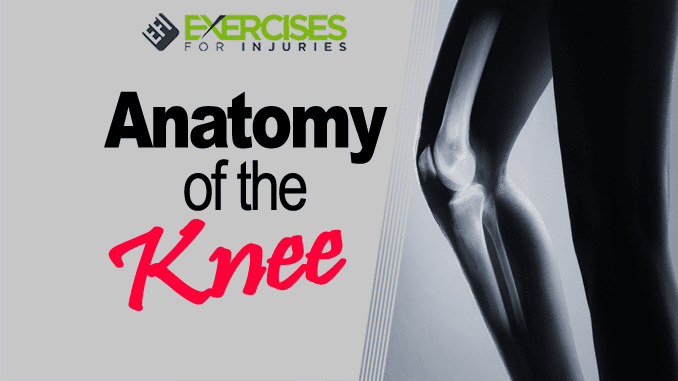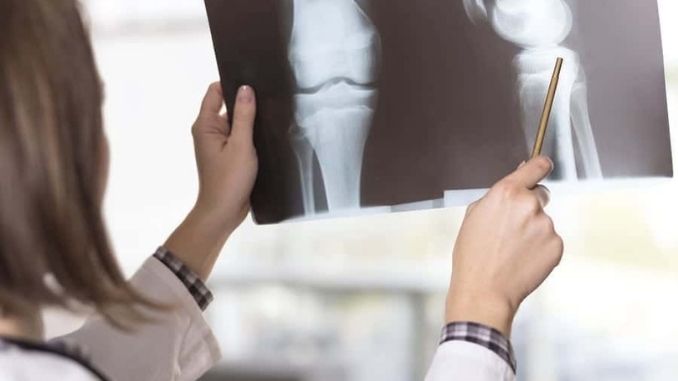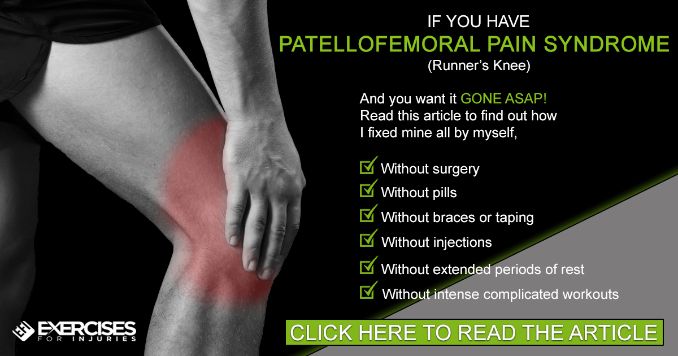
Unless you’re an orthopedist or physical therapist, you probably never think much about knee anatomy. That is until you twist, bang, sprain or feel knee pain. Then, you ask suddenly, “What’s inside there?” Well, you are about to find out. Plus, we’ll take a look at some of the most common knee injuries and ailments.

Knee Anatomy Main Components
The knee is the largest joint in your body | 404, and it’s one of the most active. The knee has several main components, which are:
- Bones: There are three: the femur (thigh bone), tibia (shinbone) and patella (knee cap)
- Articular cartilage: Wherever the bones make contact with each other, they have a cartilage cover to promote smooth movement
- Meniscus: These are two C-shaped wedges of cartilage that act as shock absorbers for the knee
- Ligaments: Strong fibrous tissue that connects bone to bone; you have four ligaments in your knee
- Tendons: Fibrous bands that connect muscle to bone; there are 12 muscles that affect knee movement
- Bursae: There are at least 11 of these small sacs of fluid that serve for smooth movement and cushioning
- Network of blood vessels and nerves: These are found throughout the knee
Hard at Work
Few joints work as hard as your knee. The average adult walks 5,000 to 7,000 steps per day. This could easily be tripled or quadrupled if your work requires a lot of walking. When you run, five times your bodyweight comes crashing down on each knee with every stride. Moreover, it takes an average of 1,064 strides to complete a one-mile run, which is a total of 2,660 times your bodyweight pounding down on the knee.
Even though you might think the knee is a simple hinge joint, it’s much more complex. The knee can also rotate, and coordination with the hip and ankle are critical for normal human mobility. Moreover, let’s look at some common injuries and conditions that affect the knee.
Patella Fracture
Anatomy of the Knee: A broken knee cap is the most common knee fracture since it’s the spot most likely to receive impact. Still, the kneecap is extremely strong and has plenty of cushioning bursae around it. A very high-energy impact is required to fracture the patella.
The severity of the fracture determines the treatment. Initially, you should place a bag of ice wrapped in a damp cloth on the knee. moreover, avoid placing ice directly on the knee. Next, if you have a lot of pain, you’ll want to be examined by a doctor and have an X-ray taken.
If your patella is fairly intact, the treatment is rest and possibly splinting of the joint. If pieces of the patella are broken and out of place, surgery is required to reconstruct the bone.
Other Knee Fractures
Anatomy of the Knee: Patella fractures are by far the most common knee fracture. Still, the other knee bones can be broken as well. A distal femur fracture: This is a break at the end of the thigh bone. Typically, this only occurs in older adults who have weakened bones due to osteoporosis. Cancer, infection or mineral deficiency can also weaken the bones. Very high-impact injuries, such as car accidents, may cause fractures in the distal femur.
A proximal tibia fracture is a fracture of the top of the shin bone. This could happen due to excessive activity, trauma or a weakened bone.
Furthermore, the fracture type and severity determine the treatment. In some cases, rest and casting may be sufficient. In more severe breaks or in persons who are very physically active, surgery may be recommended.

Knee Dislocation
If any of the bones of the knee are out of place for any reason, it’s called a dislocation. If your knee anatomy is abnormal, your knee can dislocate even just by walking. Otherwise, knee dislocation may be caused by a fall or high-speed impacts, such as a sports injury or car accident.
With knee movement, your patella typically slides along a groove in the knee joint. Sometimes, the patella gets dislocated out of the groove. This can cause knee instability, catching, swelling, stiffness or pain.
Sometimes, the patella will “pop” back into place spontaneously. Otherwise, your doctor may have to move the patella back into place by hand. Moreover, if your patella chronically moves in and out of place, you may need surgery. One technique is to tighten the tendons that keep the patella in its groove.
Knee Ligament Injuries
Here’s a list of the most common knee ligament injuries:
- Anterior cruciate ligament (ACL) injury: The anterior cruciate ligament (ACL) is a ligament deep inside the knee that connects your femur to your tibia; this ligament can be strained or torn when you stop or pivot suddenly during a run, and impact from a tackle can also cause ACL injury
- Posterior cruciate ligament (PCL) injury: Crosses with the ACL to provide internal knee support; the posterior cruciate ligament (PCL) can be damaged from knee twisting or impact injuries to the front of the knee or shinbone
- Collateral ligament injury: You have a collateral ligament on each side of your knee; a collateral ligament strain or tear is usually due to impact to the side of the knee
Knee ligament injury symptoms can vary from mild to severe pain, swelling and knee instability. Much like fractures, the severity of the ligament injury determines the treatment. For very severe tears, surgery may be required. Also, highly competitive athletes may request surgery to regain the maximum function possible.
Meniscus Tear
The menisci are two C-shaped wedges in each knee that can deteriorate over time. This may happen with arthritis, which can also lead to a meniscus tear. Any knee injury may result in a traumatic tear. Some symptoms of a meniscus tear are pain, locking, stiffness and joint instability.
In the past, surgery was frequently recommended for a meniscus tear. However, more recent research shows that the benefit of surgery is marginal in most cases. Typically, a comprehensive rehabilitation program will restore a significant amount of knee function. Increasingly, surgery is only being used in cases of severe pain that don’t improve with physical therapy.
Read more about Meniscus injuries and treatments here.
Knee Tendon Tear and Tendonitis
12 muscles surround and attach to the bones via tendons around the knee. Any injury to the knee could result in a tendon strain or tear. Falls, jumping or impacts are the most common causes of knee tendon injury. Tendon injury treatment depends on the severity and symptoms. For instance, a complete tear may require stitching the tendon to the bone to restore normal knee function.
Tendonitis may occur after injury or due to overuse of the knee. For example, patellar tendonitis is soreness and inflammation of the tendon that connects your knee cap to the tibia. Moreover, the treatment for tendonitis is rest, ice, anti-inflammatory medications and physical therapy.
Knee Bursitis
The bursae are tiny sacs found throughout the knee that helps with smooth movement and cushioning. With overuse or injury, bursae can get irritated and inflamed, leading to a condition called bursitis. This may occur if your job or activity includes frequent bending or kneeling. For instance, carpet installers may be more prone to bursitis in front of the patella (prepatellar bursitis). Moreover, if bacteria infect the bursa, it’s called infectious bursitis.
Treatment of bursitis includes rest, ice and anti-inflammatory medications. If an infection is present, you’ll need antibiotics.

Iliotibial Band Syndrome
The iliotibial (IT) band is a group of fibers that runs from your hip to the outside of your knee. The IT band provides overall stability between your hip and leg. With chronic overuse, this band can become irritated and inflamed. IT band syndrome often presents with pain on the outside of the knee. It’s more common in runners who do a lot of running downhill.
Knee Arthritis
The term “arthritis” can be applied to many different disorders. Generally, it means a problem with the knee that causes pain and/or inflammation. The more common types of knee arthritis are:
- Osteoarthritis: Arthritis of age or wear and tear and is the leading cause of knee pain for those over 50 years old; causes stiffness, pain and swelling
- Rheumatoid arthritis: An autoimmune disease that typically affects more than just one joint and also affects other body systems; this condition requires a specialist for adequate treatment
- Psoriatic arthritis: Usually starts with a skin rash first (psoriasis); up to 30 percent of those who have psoriasis will develop psoriatic arthritis
Knee Joint Infection
Sometimes, the knee joint can get infected with a bacteria, virus or fungi. This condition is called septic arthritis, and it’s more common in young children or older adults. Also, people who have a weakened immune system, due to HIV, cancer, diabetes, drug use, or other issues, are more likely to get septic arthritis. The symptoms of septic arthritis are joint pain, swelling and fever.
Treatment for septic arthritis includes intravenous antibiotics and draining the knee of any infected fluid. In severe cases, joint surgery may be necessary to drain and clean out the knee joint.
If you are looking for a fast, simple, safe and effective program to eliminate your stubborn knee pain and patellofemoral pain syndrome, then check out the Patellofemoral Pain Syndrome Solution program, here!

